Australian Dairy Industry Competitiveness
VerifiedAdded on 2020/03/07
|13
|2765
|104
AI Summary
This assignment examines the competitive strategies employed by the Australian dairy industry. It analyzes the potential impact of diversification on operational costs and returns. The paper explores how the industry can apply Porter's competitive strategies—cost leadership, differentiation, and focus—to gain a competitive advantage over rivals like New Zealand. The discussion also considers the use of capital-intensive technology to reduce labor costs.
Contribute Materials
Your contribution can guide someone’s learning journey. Share your
documents today.
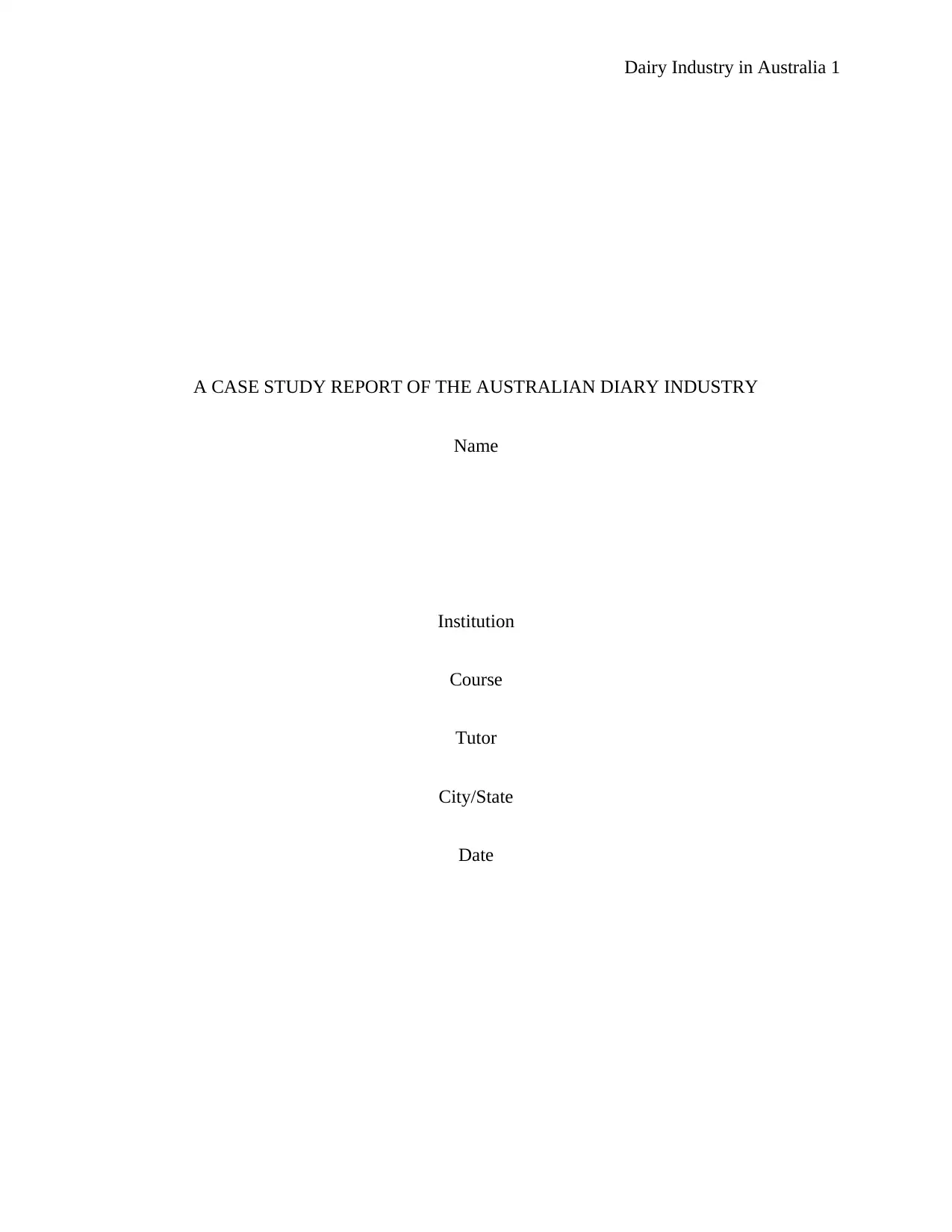
Dairy Industry in Australia 1
A CASE STUDY REPORT OF THE AUSTRALIAN DIARY INDUSTRY
Name
Institution
Course
Tutor
City/State
Date
A CASE STUDY REPORT OF THE AUSTRALIAN DIARY INDUSTRY
Name
Institution
Course
Tutor
City/State
Date
Secure Best Marks with AI Grader
Need help grading? Try our AI Grader for instant feedback on your assignments.
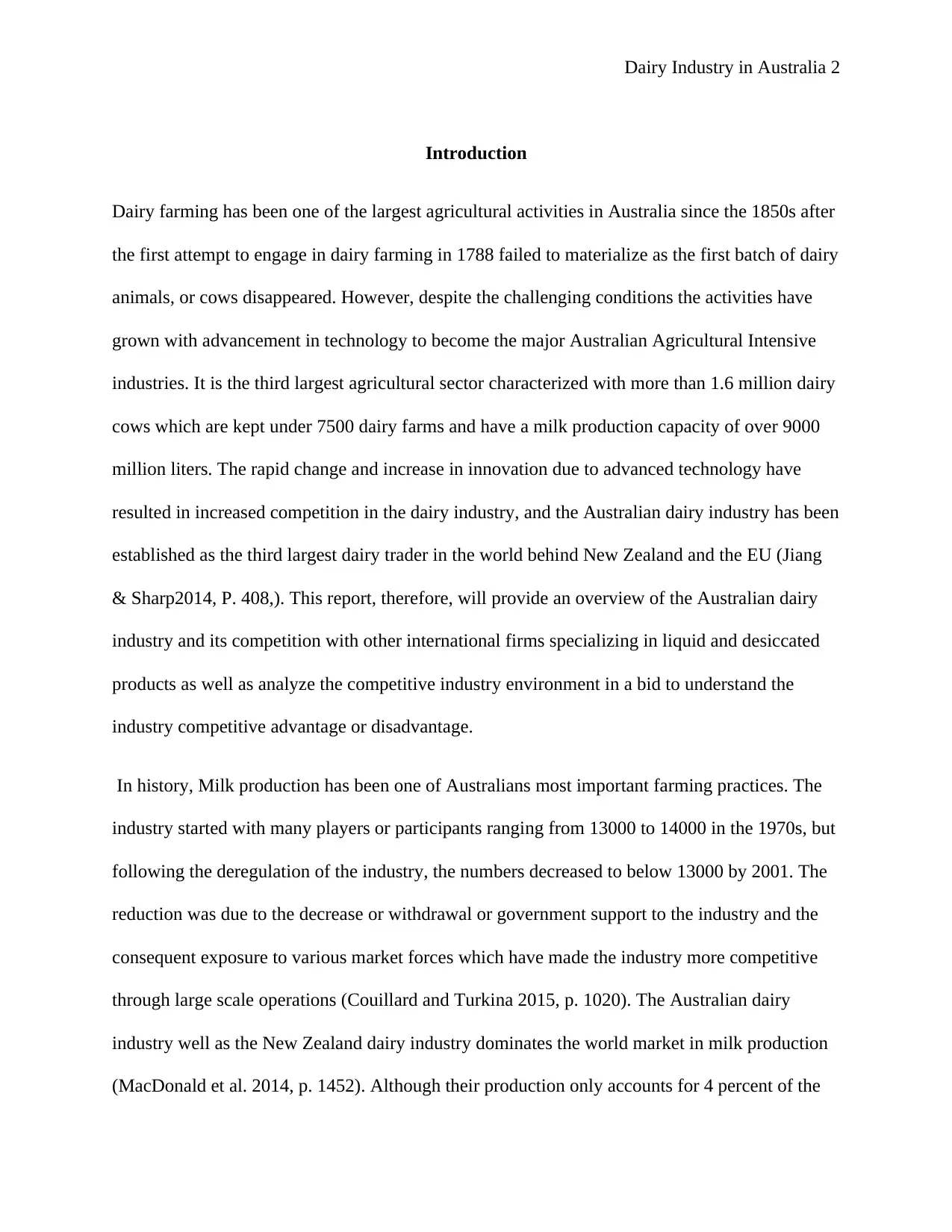
Dairy Industry in Australia 2
Introduction
Dairy farming has been one of the largest agricultural activities in Australia since the 1850s after
the first attempt to engage in dairy farming in 1788 failed to materialize as the first batch of dairy
animals, or cows disappeared. However, despite the challenging conditions the activities have
grown with advancement in technology to become the major Australian Agricultural Intensive
industries. It is the third largest agricultural sector characterized with more than 1.6 million dairy
cows which are kept under 7500 dairy farms and have a milk production capacity of over 9000
million liters. The rapid change and increase in innovation due to advanced technology have
resulted in increased competition in the dairy industry, and the Australian dairy industry has been
established as the third largest dairy trader in the world behind New Zealand and the EU (Jiang
& Sharp2014, P. 408,). This report, therefore, will provide an overview of the Australian dairy
industry and its competition with other international firms specializing in liquid and desiccated
products as well as analyze the competitive industry environment in a bid to understand the
industry competitive advantage or disadvantage.
In history, Milk production has been one of Australians most important farming practices. The
industry started with many players or participants ranging from 13000 to 14000 in the 1970s, but
following the deregulation of the industry, the numbers decreased to below 13000 by 2001. The
reduction was due to the decrease or withdrawal or government support to the industry and the
consequent exposure to various market forces which have made the industry more competitive
through large scale operations (Couillard and Turkina 2015, p. 1020). The Australian dairy
industry well as the New Zealand dairy industry dominates the world market in milk production
(MacDonald et al. 2014, p. 1452). Although their production only accounts for 4 percent of the
Introduction
Dairy farming has been one of the largest agricultural activities in Australia since the 1850s after
the first attempt to engage in dairy farming in 1788 failed to materialize as the first batch of dairy
animals, or cows disappeared. However, despite the challenging conditions the activities have
grown with advancement in technology to become the major Australian Agricultural Intensive
industries. It is the third largest agricultural sector characterized with more than 1.6 million dairy
cows which are kept under 7500 dairy farms and have a milk production capacity of over 9000
million liters. The rapid change and increase in innovation due to advanced technology have
resulted in increased competition in the dairy industry, and the Australian dairy industry has been
established as the third largest dairy trader in the world behind New Zealand and the EU (Jiang
& Sharp2014, P. 408,). This report, therefore, will provide an overview of the Australian dairy
industry and its competition with other international firms specializing in liquid and desiccated
products as well as analyze the competitive industry environment in a bid to understand the
industry competitive advantage or disadvantage.
In history, Milk production has been one of Australians most important farming practices. The
industry started with many players or participants ranging from 13000 to 14000 in the 1970s, but
following the deregulation of the industry, the numbers decreased to below 13000 by 2001. The
reduction was due to the decrease or withdrawal or government support to the industry and the
consequent exposure to various market forces which have made the industry more competitive
through large scale operations (Couillard and Turkina 2015, p. 1020). The Australian dairy
industry well as the New Zealand dairy industry dominates the world market in milk production
(MacDonald et al. 2014, p. 1452). Although their production only accounts for 4 percent of the
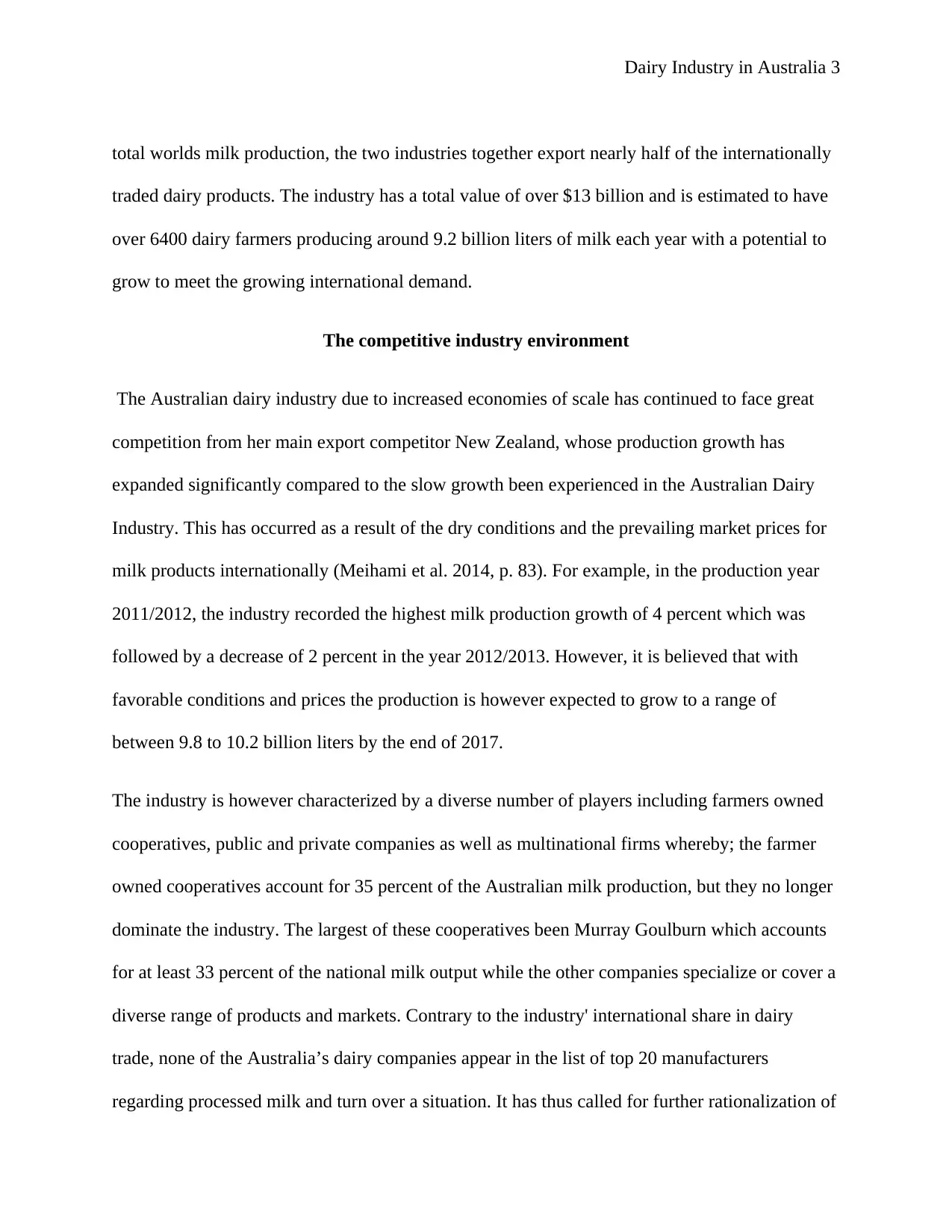
Dairy Industry in Australia 3
total worlds milk production, the two industries together export nearly half of the internationally
traded dairy products. The industry has a total value of over $13 billion and is estimated to have
over 6400 dairy farmers producing around 9.2 billion liters of milk each year with a potential to
grow to meet the growing international demand.
The competitive industry environment
The Australian dairy industry due to increased economies of scale has continued to face great
competition from her main export competitor New Zealand, whose production growth has
expanded significantly compared to the slow growth been experienced in the Australian Dairy
Industry. This has occurred as a result of the dry conditions and the prevailing market prices for
milk products internationally (Meihami et al. 2014, p. 83). For example, in the production year
2011/2012, the industry recorded the highest milk production growth of 4 percent which was
followed by a decrease of 2 percent in the year 2012/2013. However, it is believed that with
favorable conditions and prices the production is however expected to grow to a range of
between 9.8 to 10.2 billion liters by the end of 2017.
The industry is however characterized by a diverse number of players including farmers owned
cooperatives, public and private companies as well as multinational firms whereby; the farmer
owned cooperatives account for 35 percent of the Australian milk production, but they no longer
dominate the industry. The largest of these cooperatives been Murray Goulburn which accounts
for at least 33 percent of the national milk output while the other companies specialize or cover a
diverse range of products and markets. Contrary to the industry' international share in dairy
trade, none of the Australia’s dairy companies appear in the list of top 20 manufacturers
regarding processed milk and turn over a situation. It has thus called for further rationalization of
total worlds milk production, the two industries together export nearly half of the internationally
traded dairy products. The industry has a total value of over $13 billion and is estimated to have
over 6400 dairy farmers producing around 9.2 billion liters of milk each year with a potential to
grow to meet the growing international demand.
The competitive industry environment
The Australian dairy industry due to increased economies of scale has continued to face great
competition from her main export competitor New Zealand, whose production growth has
expanded significantly compared to the slow growth been experienced in the Australian Dairy
Industry. This has occurred as a result of the dry conditions and the prevailing market prices for
milk products internationally (Meihami et al. 2014, p. 83). For example, in the production year
2011/2012, the industry recorded the highest milk production growth of 4 percent which was
followed by a decrease of 2 percent in the year 2012/2013. However, it is believed that with
favorable conditions and prices the production is however expected to grow to a range of
between 9.8 to 10.2 billion liters by the end of 2017.
The industry is however characterized by a diverse number of players including farmers owned
cooperatives, public and private companies as well as multinational firms whereby; the farmer
owned cooperatives account for 35 percent of the Australian milk production, but they no longer
dominate the industry. The largest of these cooperatives been Murray Goulburn which accounts
for at least 33 percent of the national milk output while the other companies specialize or cover a
diverse range of products and markets. Contrary to the industry' international share in dairy
trade, none of the Australia’s dairy companies appear in the list of top 20 manufacturers
regarding processed milk and turn over a situation. It has thus called for further rationalization of
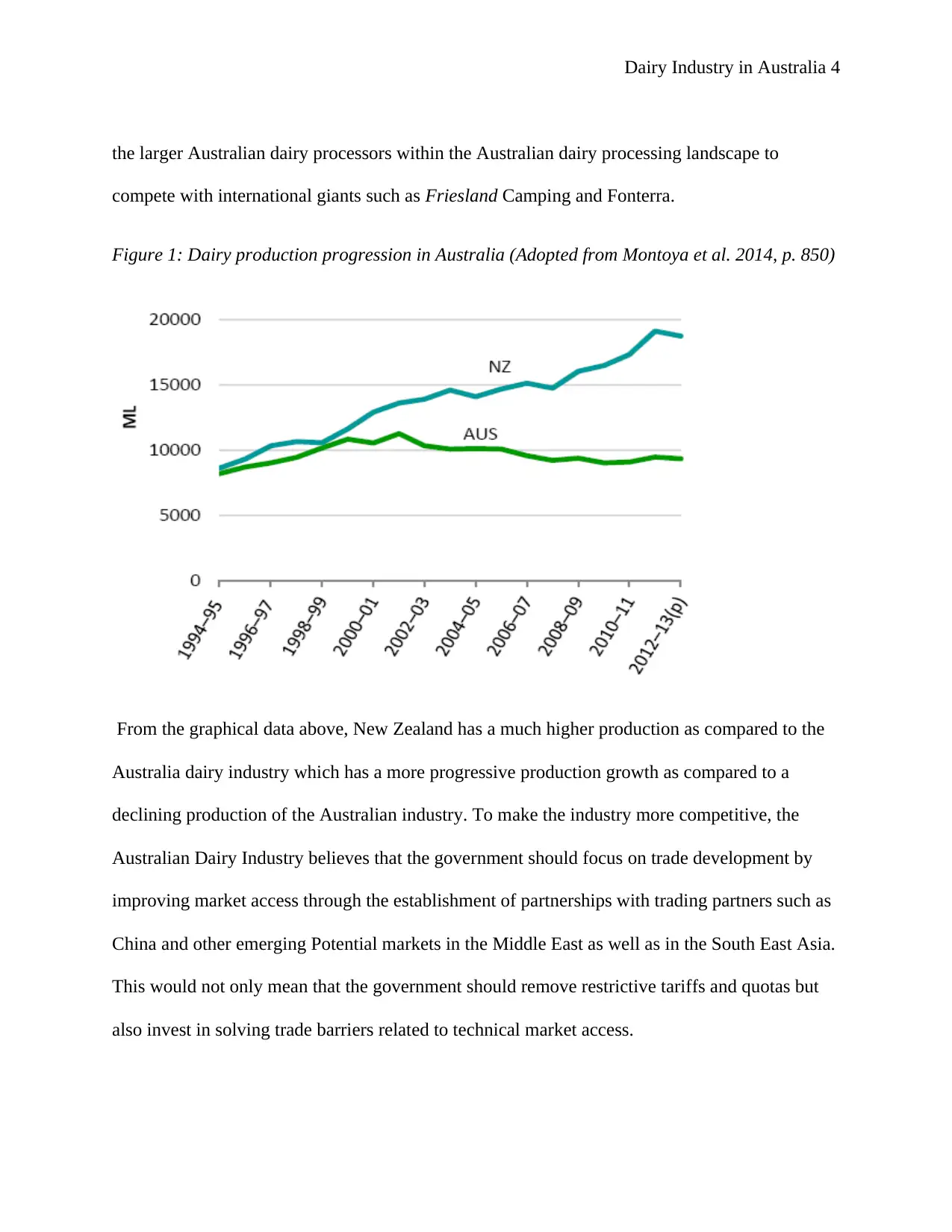
Dairy Industry in Australia 4
the larger Australian dairy processors within the Australian dairy processing landscape to
compete with international giants such as Friesland Camping and Fonterra.
Figure 1: Dairy production progression in Australia (Adopted from Montoya et al. 2014, p. 850)
From the graphical data above, New Zealand has a much higher production as compared to the
Australia dairy industry which has a more progressive production growth as compared to a
declining production of the Australian industry. To make the industry more competitive, the
Australian Dairy Industry believes that the government should focus on trade development by
improving market access through the establishment of partnerships with trading partners such as
China and other emerging Potential markets in the Middle East as well as in the South East Asia.
This would not only mean that the government should remove restrictive tariffs and quotas but
also invest in solving trade barriers related to technical market access.
the larger Australian dairy processors within the Australian dairy processing landscape to
compete with international giants such as Friesland Camping and Fonterra.
Figure 1: Dairy production progression in Australia (Adopted from Montoya et al. 2014, p. 850)
From the graphical data above, New Zealand has a much higher production as compared to the
Australia dairy industry which has a more progressive production growth as compared to a
declining production of the Australian industry. To make the industry more competitive, the
Australian Dairy Industry believes that the government should focus on trade development by
improving market access through the establishment of partnerships with trading partners such as
China and other emerging Potential markets in the Middle East as well as in the South East Asia.
This would not only mean that the government should remove restrictive tariffs and quotas but
also invest in solving trade barriers related to technical market access.
Secure Best Marks with AI Grader
Need help grading? Try our AI Grader for instant feedback on your assignments.
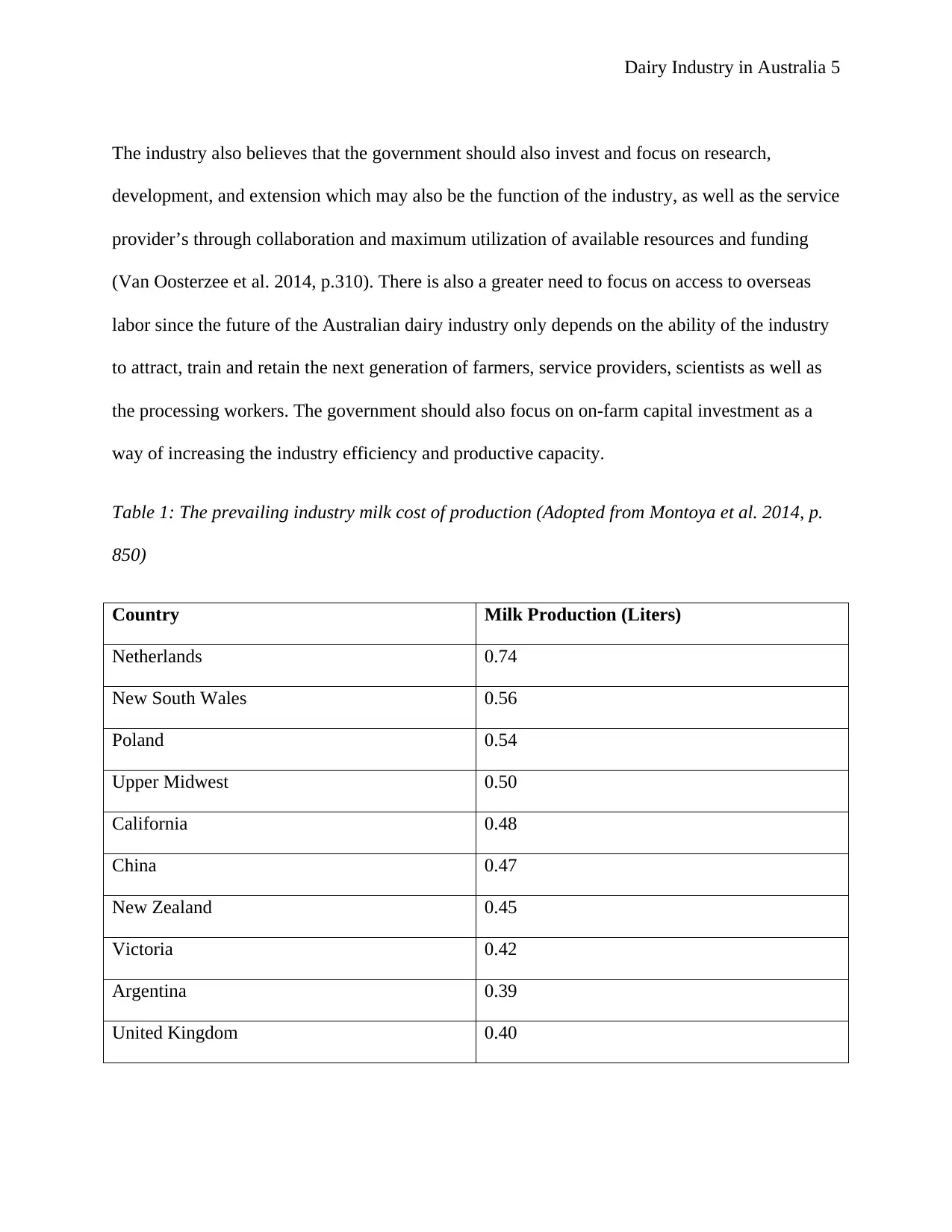
Dairy Industry in Australia 5
The industry also believes that the government should also invest and focus on research,
development, and extension which may also be the function of the industry, as well as the service
provider’s through collaboration and maximum utilization of available resources and funding
(Van Oosterzee et al. 2014, p.310). There is also a greater need to focus on access to overseas
labor since the future of the Australian dairy industry only depends on the ability of the industry
to attract, train and retain the next generation of farmers, service providers, scientists as well as
the processing workers. The government should also focus on on-farm capital investment as a
way of increasing the industry efficiency and productive capacity.
Table 1: The prevailing industry milk cost of production (Adopted from Montoya et al. 2014, p.
850)
Country Milk Production (Liters)
Netherlands 0.74
New South Wales 0.56
Poland 0.54
Upper Midwest 0.50
California 0.48
China 0.47
New Zealand 0.45
Victoria 0.42
Argentina 0.39
United Kingdom 0.40
The industry also believes that the government should also invest and focus on research,
development, and extension which may also be the function of the industry, as well as the service
provider’s through collaboration and maximum utilization of available resources and funding
(Van Oosterzee et al. 2014, p.310). There is also a greater need to focus on access to overseas
labor since the future of the Australian dairy industry only depends on the ability of the industry
to attract, train and retain the next generation of farmers, service providers, scientists as well as
the processing workers. The government should also focus on on-farm capital investment as a
way of increasing the industry efficiency and productive capacity.
Table 1: The prevailing industry milk cost of production (Adopted from Montoya et al. 2014, p.
850)
Country Milk Production (Liters)
Netherlands 0.74
New South Wales 0.56
Poland 0.54
Upper Midwest 0.50
California 0.48
China 0.47
New Zealand 0.45
Victoria 0.42
Argentina 0.39
United Kingdom 0.40
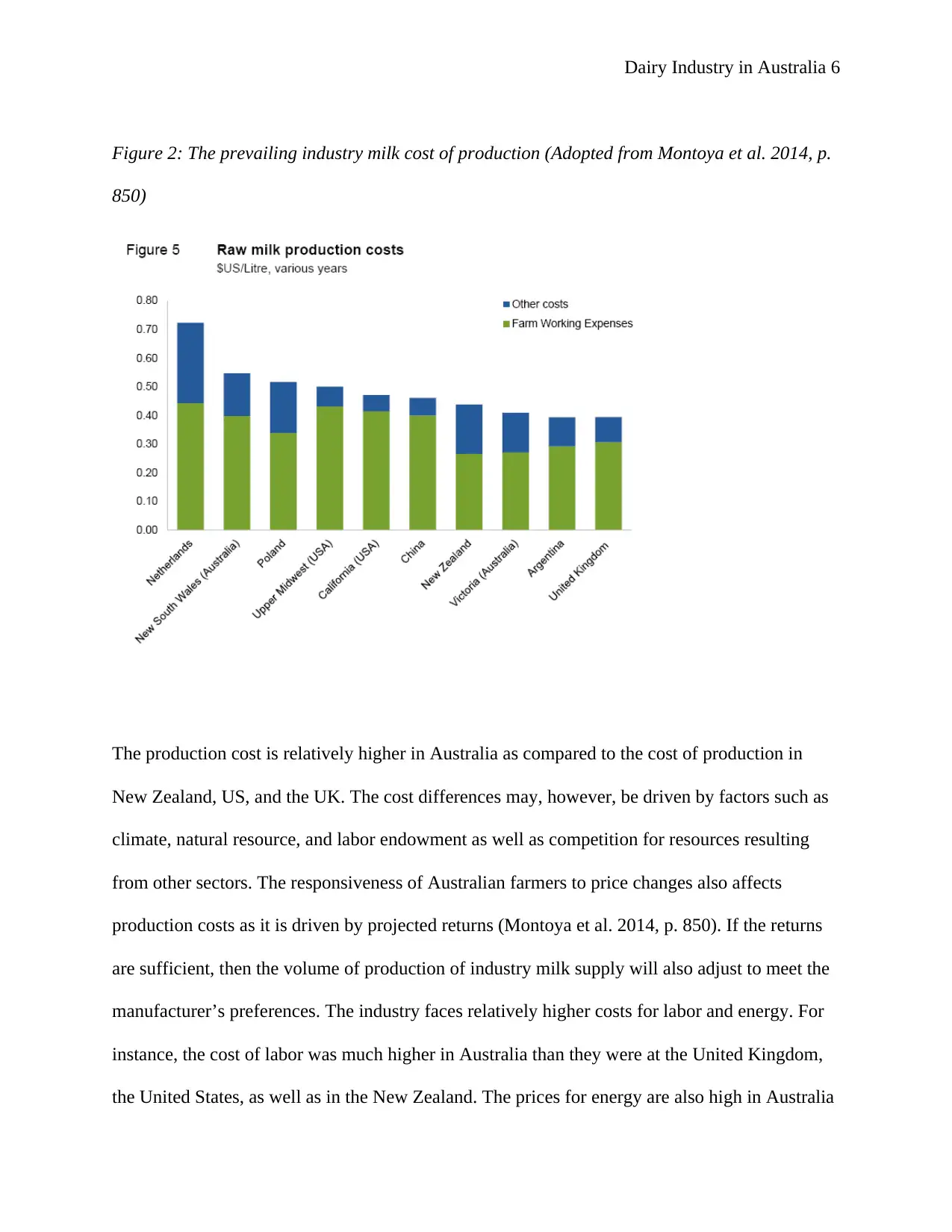
Dairy Industry in Australia 6
Figure 2: The prevailing industry milk cost of production (Adopted from Montoya et al. 2014, p.
850)
The production cost is relatively higher in Australia as compared to the cost of production in
New Zealand, US, and the UK. The cost differences may, however, be driven by factors such as
climate, natural resource, and labor endowment as well as competition for resources resulting
from other sectors. The responsiveness of Australian farmers to price changes also affects
production costs as it is driven by projected returns (Montoya et al. 2014, p. 850). If the returns
are sufficient, then the volume of production of industry milk supply will also adjust to meet the
manufacturer’s preferences. The industry faces relatively higher costs for labor and energy. For
instance, the cost of labor was much higher in Australia than they were at the United Kingdom,
the United States, as well as in the New Zealand. The prices for energy are also high in Australia
Figure 2: The prevailing industry milk cost of production (Adopted from Montoya et al. 2014, p.
850)
The production cost is relatively higher in Australia as compared to the cost of production in
New Zealand, US, and the UK. The cost differences may, however, be driven by factors such as
climate, natural resource, and labor endowment as well as competition for resources resulting
from other sectors. The responsiveness of Australian farmers to price changes also affects
production costs as it is driven by projected returns (Montoya et al. 2014, p. 850). If the returns
are sufficient, then the volume of production of industry milk supply will also adjust to meet the
manufacturer’s preferences. The industry faces relatively higher costs for labor and energy. For
instance, the cost of labor was much higher in Australia than they were at the United Kingdom,
the United States, as well as in the New Zealand. The prices for energy are also high in Australia
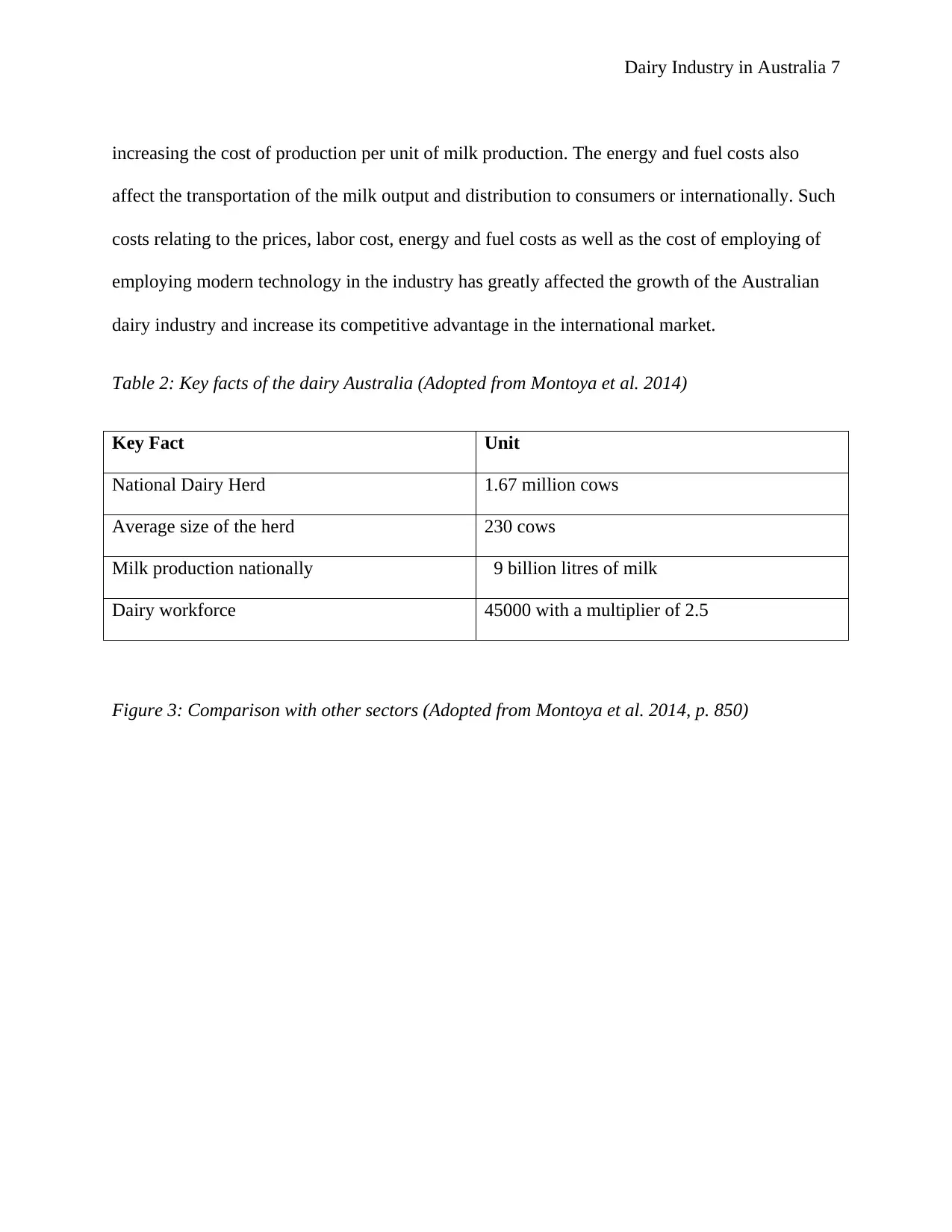
Dairy Industry in Australia 7
increasing the cost of production per unit of milk production. The energy and fuel costs also
affect the transportation of the milk output and distribution to consumers or internationally. Such
costs relating to the prices, labor cost, energy and fuel costs as well as the cost of employing of
employing modern technology in the industry has greatly affected the growth of the Australian
dairy industry and increase its competitive advantage in the international market.
Table 2: Key facts of the dairy Australia (Adopted from Montoya et al. 2014)
Key Fact Unit
National Dairy Herd 1.67 million cows
Average size of the herd 230 cows
Milk production nationally 9 billion litres of milk
Dairy workforce 45000 with a multiplier of 2.5
Figure 3: Comparison with other sectors (Adopted from Montoya et al. 2014, p. 850)
increasing the cost of production per unit of milk production. The energy and fuel costs also
affect the transportation of the milk output and distribution to consumers or internationally. Such
costs relating to the prices, labor cost, energy and fuel costs as well as the cost of employing of
employing modern technology in the industry has greatly affected the growth of the Australian
dairy industry and increase its competitive advantage in the international market.
Table 2: Key facts of the dairy Australia (Adopted from Montoya et al. 2014)
Key Fact Unit
National Dairy Herd 1.67 million cows
Average size of the herd 230 cows
Milk production nationally 9 billion litres of milk
Dairy workforce 45000 with a multiplier of 2.5
Figure 3: Comparison with other sectors (Adopted from Montoya et al. 2014, p. 850)
Paraphrase This Document
Need a fresh take? Get an instant paraphrase of this document with our AI Paraphraser
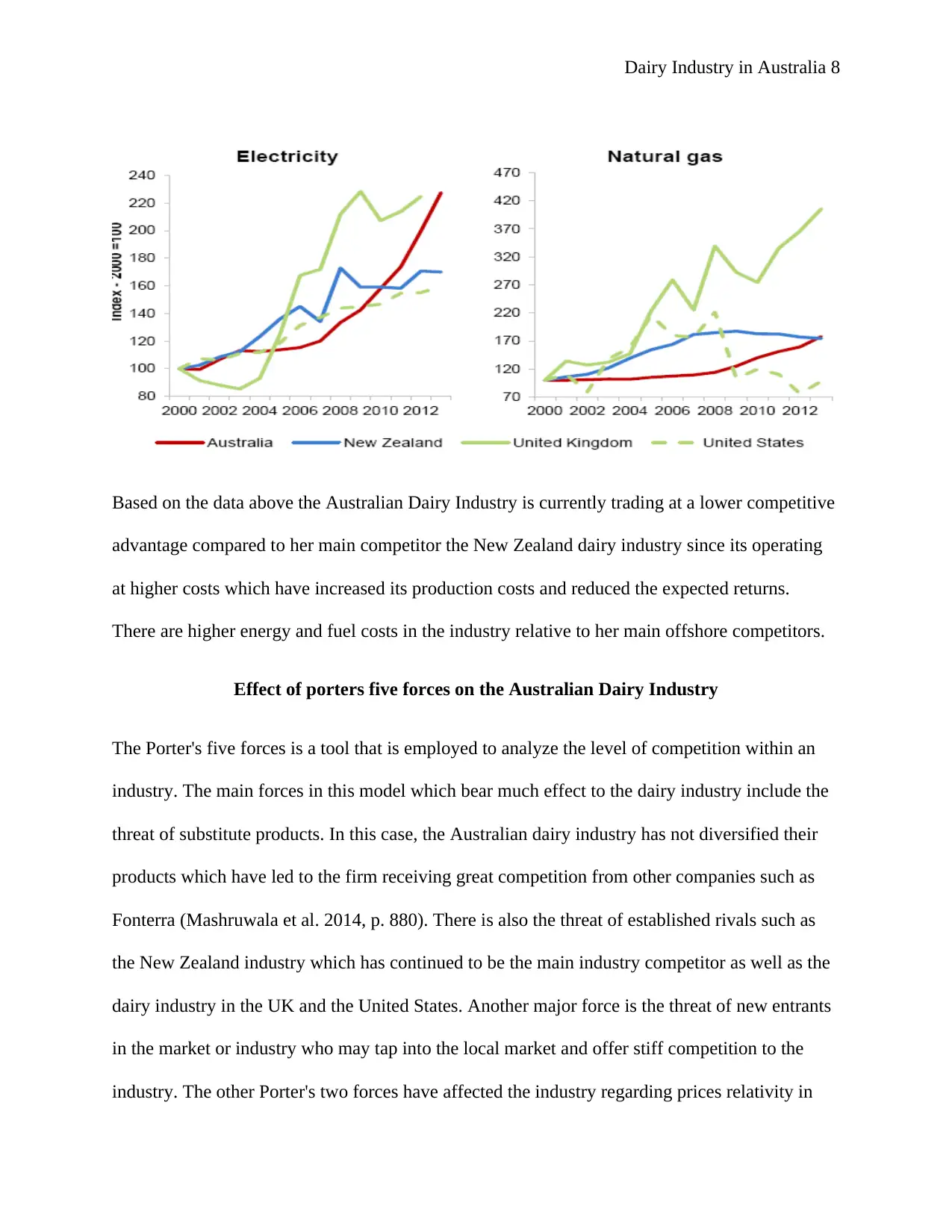
Dairy Industry in Australia 8
Based on the data above the Australian Dairy Industry is currently trading at a lower competitive
advantage compared to her main competitor the New Zealand dairy industry since its operating
at higher costs which have increased its production costs and reduced the expected returns.
There are higher energy and fuel costs in the industry relative to her main offshore competitors.
Effect of porters five forces on the Australian Dairy Industry
The Porter's five forces is a tool that is employed to analyze the level of competition within an
industry. The main forces in this model which bear much effect to the dairy industry include the
threat of substitute products. In this case, the Australian dairy industry has not diversified their
products which have led to the firm receiving great competition from other companies such as
Fonterra (Mashruwala et al. 2014, p. 880). There is also the threat of established rivals such as
the New Zealand industry which has continued to be the main industry competitor as well as the
dairy industry in the UK and the United States. Another major force is the threat of new entrants
in the market or industry who may tap into the local market and offer stiff competition to the
industry. The other Porter's two forces have affected the industry regarding prices relativity in
Based on the data above the Australian Dairy Industry is currently trading at a lower competitive
advantage compared to her main competitor the New Zealand dairy industry since its operating
at higher costs which have increased its production costs and reduced the expected returns.
There are higher energy and fuel costs in the industry relative to her main offshore competitors.
Effect of porters five forces on the Australian Dairy Industry
The Porter's five forces is a tool that is employed to analyze the level of competition within an
industry. The main forces in this model which bear much effect to the dairy industry include the
threat of substitute products. In this case, the Australian dairy industry has not diversified their
products which have led to the firm receiving great competition from other companies such as
Fonterra (Mashruwala et al. 2014, p. 880). There is also the threat of established rivals such as
the New Zealand industry which has continued to be the main industry competitor as well as the
dairy industry in the UK and the United States. Another major force is the threat of new entrants
in the market or industry who may tap into the local market and offer stiff competition to the
industry. The other Porter's two forces have affected the industry regarding prices relativity in
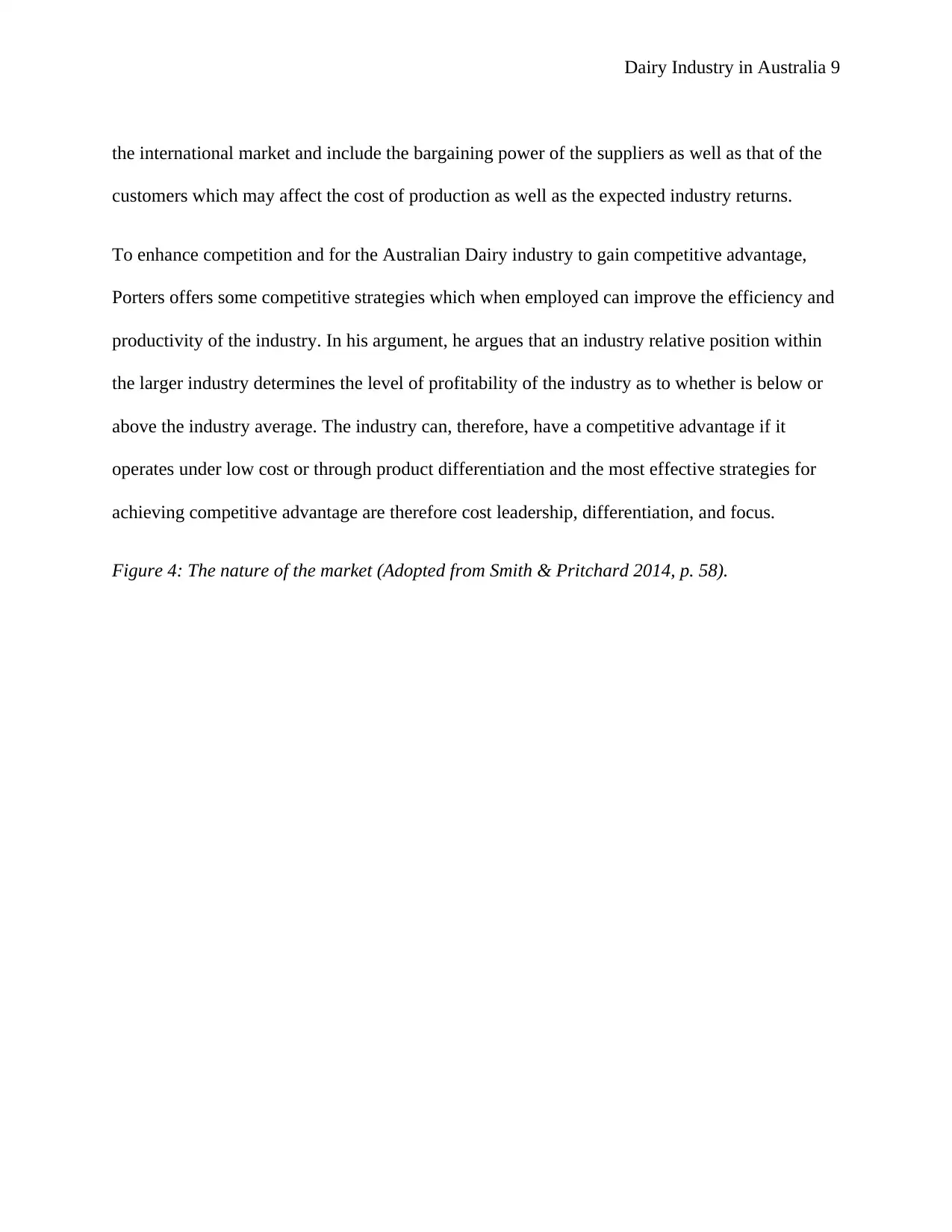
Dairy Industry in Australia 9
the international market and include the bargaining power of the suppliers as well as that of the
customers which may affect the cost of production as well as the expected industry returns.
To enhance competition and for the Australian Dairy industry to gain competitive advantage,
Porters offers some competitive strategies which when employed can improve the efficiency and
productivity of the industry. In his argument, he argues that an industry relative position within
the larger industry determines the level of profitability of the industry as to whether is below or
above the industry average. The industry can, therefore, have a competitive advantage if it
operates under low cost or through product differentiation and the most effective strategies for
achieving competitive advantage are therefore cost leadership, differentiation, and focus.
Figure 4: The nature of the market (Adopted from Smith & Pritchard 2014, p. 58).
the international market and include the bargaining power of the suppliers as well as that of the
customers which may affect the cost of production as well as the expected industry returns.
To enhance competition and for the Australian Dairy industry to gain competitive advantage,
Porters offers some competitive strategies which when employed can improve the efficiency and
productivity of the industry. In his argument, he argues that an industry relative position within
the larger industry determines the level of profitability of the industry as to whether is below or
above the industry average. The industry can, therefore, have a competitive advantage if it
operates under low cost or through product differentiation and the most effective strategies for
achieving competitive advantage are therefore cost leadership, differentiation, and focus.
Figure 4: The nature of the market (Adopted from Smith & Pritchard 2014, p. 58).
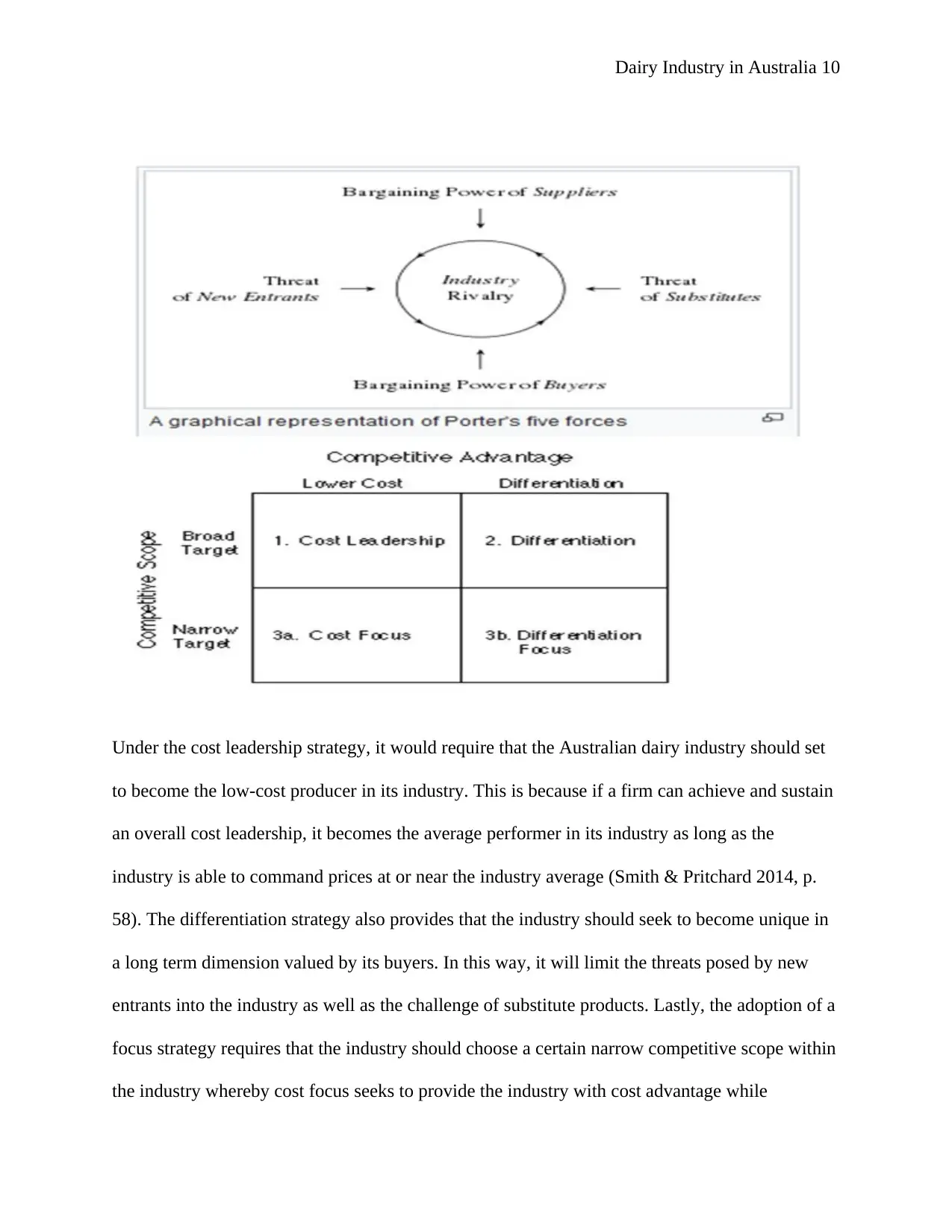
Dairy Industry in Australia 10
Under the cost leadership strategy, it would require that the Australian dairy industry should set
to become the low-cost producer in its industry. This is because if a firm can achieve and sustain
an overall cost leadership, it becomes the average performer in its industry as long as the
industry is able to command prices at or near the industry average (Smith & Pritchard 2014, p.
58). The differentiation strategy also provides that the industry should seek to become unique in
a long term dimension valued by its buyers. In this way, it will limit the threats posed by new
entrants into the industry as well as the challenge of substitute products. Lastly, the adoption of a
focus strategy requires that the industry should choose a certain narrow competitive scope within
the industry whereby cost focus seeks to provide the industry with cost advantage while
Under the cost leadership strategy, it would require that the Australian dairy industry should set
to become the low-cost producer in its industry. This is because if a firm can achieve and sustain
an overall cost leadership, it becomes the average performer in its industry as long as the
industry is able to command prices at or near the industry average (Smith & Pritchard 2014, p.
58). The differentiation strategy also provides that the industry should seek to become unique in
a long term dimension valued by its buyers. In this way, it will limit the threats posed by new
entrants into the industry as well as the challenge of substitute products. Lastly, the adoption of a
focus strategy requires that the industry should choose a certain narrow competitive scope within
the industry whereby cost focus seeks to provide the industry with cost advantage while
Secure Best Marks with AI Grader
Need help grading? Try our AI Grader for instant feedback on your assignments.
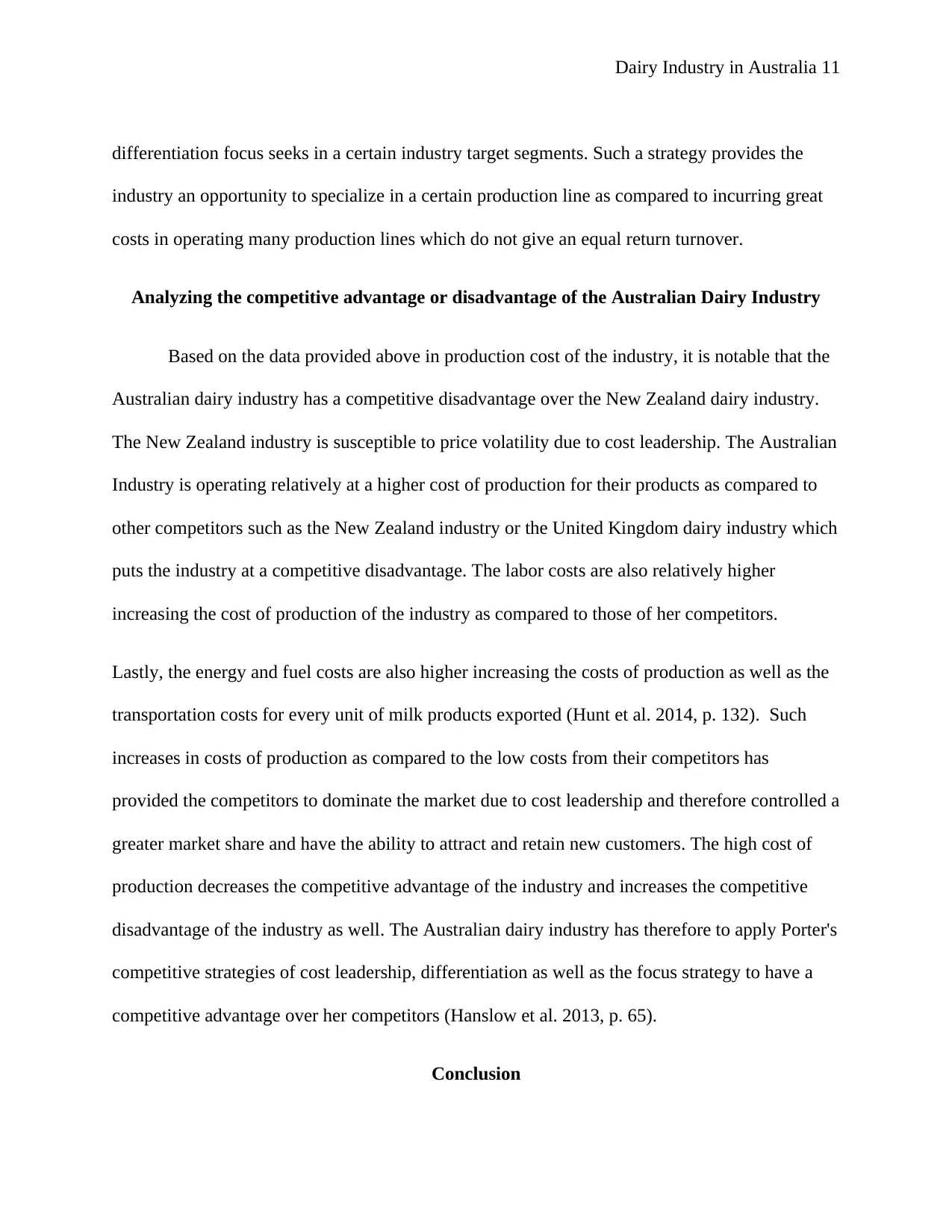
Dairy Industry in Australia 11
differentiation focus seeks in a certain industry target segments. Such a strategy provides the
industry an opportunity to specialize in a certain production line as compared to incurring great
costs in operating many production lines which do not give an equal return turnover.
Analyzing the competitive advantage or disadvantage of the Australian Dairy Industry
Based on the data provided above in production cost of the industry, it is notable that the
Australian dairy industry has a competitive disadvantage over the New Zealand dairy industry.
The New Zealand industry is susceptible to price volatility due to cost leadership. The Australian
Industry is operating relatively at a higher cost of production for their products as compared to
other competitors such as the New Zealand industry or the United Kingdom dairy industry which
puts the industry at a competitive disadvantage. The labor costs are also relatively higher
increasing the cost of production of the industry as compared to those of her competitors.
Lastly, the energy and fuel costs are also higher increasing the costs of production as well as the
transportation costs for every unit of milk products exported (Hunt et al. 2014, p. 132). Such
increases in costs of production as compared to the low costs from their competitors has
provided the competitors to dominate the market due to cost leadership and therefore controlled a
greater market share and have the ability to attract and retain new customers. The high cost of
production decreases the competitive advantage of the industry and increases the competitive
disadvantage of the industry as well. The Australian dairy industry has therefore to apply Porter's
competitive strategies of cost leadership, differentiation as well as the focus strategy to have a
competitive advantage over her competitors (Hanslow et al. 2013, p. 65).
Conclusion
differentiation focus seeks in a certain industry target segments. Such a strategy provides the
industry an opportunity to specialize in a certain production line as compared to incurring great
costs in operating many production lines which do not give an equal return turnover.
Analyzing the competitive advantage or disadvantage of the Australian Dairy Industry
Based on the data provided above in production cost of the industry, it is notable that the
Australian dairy industry has a competitive disadvantage over the New Zealand dairy industry.
The New Zealand industry is susceptible to price volatility due to cost leadership. The Australian
Industry is operating relatively at a higher cost of production for their products as compared to
other competitors such as the New Zealand industry or the United Kingdom dairy industry which
puts the industry at a competitive disadvantage. The labor costs are also relatively higher
increasing the cost of production of the industry as compared to those of her competitors.
Lastly, the energy and fuel costs are also higher increasing the costs of production as well as the
transportation costs for every unit of milk products exported (Hunt et al. 2014, p. 132). Such
increases in costs of production as compared to the low costs from their competitors has
provided the competitors to dominate the market due to cost leadership and therefore controlled a
greater market share and have the ability to attract and retain new customers. The high cost of
production decreases the competitive advantage of the industry and increases the competitive
disadvantage of the industry as well. The Australian dairy industry has therefore to apply Porter's
competitive strategies of cost leadership, differentiation as well as the focus strategy to have a
competitive advantage over her competitors (Hanslow et al. 2013, p. 65).
Conclusion
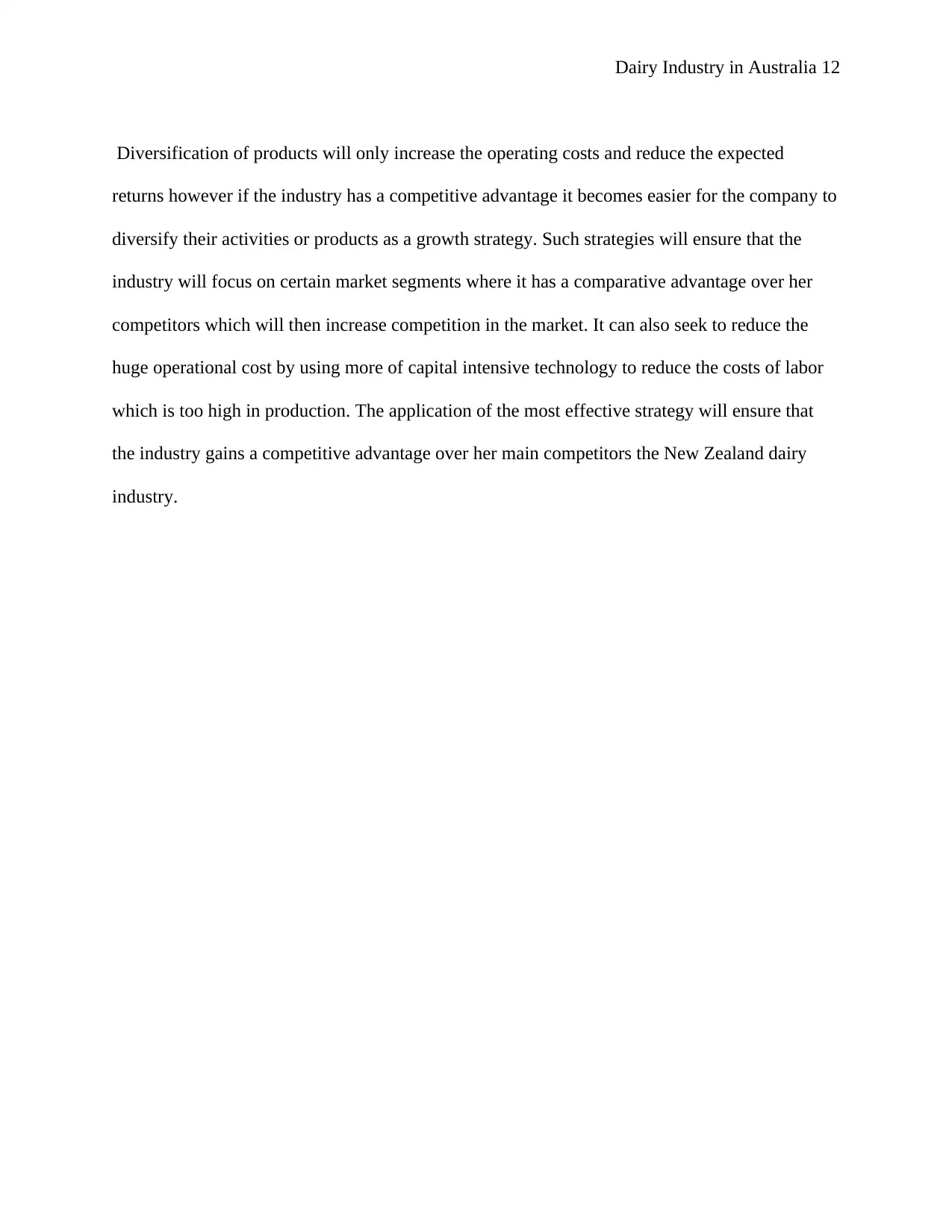
Dairy Industry in Australia 12
Diversification of products will only increase the operating costs and reduce the expected
returns however if the industry has a competitive advantage it becomes easier for the company to
diversify their activities or products as a growth strategy. Such strategies will ensure that the
industry will focus on certain market segments where it has a comparative advantage over her
competitors which will then increase competition in the market. It can also seek to reduce the
huge operational cost by using more of capital intensive technology to reduce the costs of labor
which is too high in production. The application of the most effective strategy will ensure that
the industry gains a competitive advantage over her main competitors the New Zealand dairy
industry.
Diversification of products will only increase the operating costs and reduce the expected
returns however if the industry has a competitive advantage it becomes easier for the company to
diversify their activities or products as a growth strategy. Such strategies will ensure that the
industry will focus on certain market segments where it has a comparative advantage over her
competitors which will then increase competition in the market. It can also seek to reduce the
huge operational cost by using more of capital intensive technology to reduce the costs of labor
which is too high in production. The application of the most effective strategy will ensure that
the industry gains a competitive advantage over her main competitors the New Zealand dairy
industry.
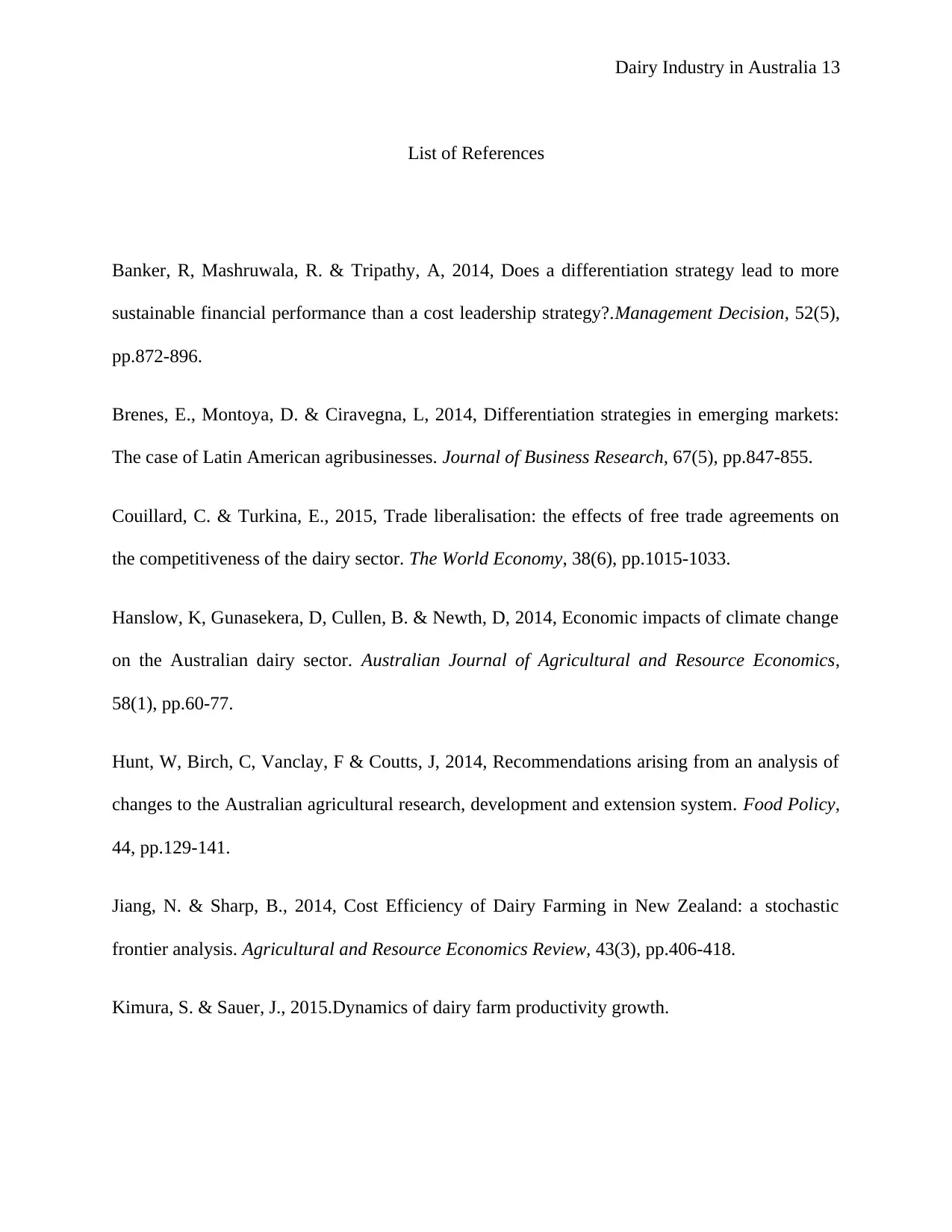
Dairy Industry in Australia 13
List of References
Banker, R, Mashruwala, R. & Tripathy, A, 2014, Does a differentiation strategy lead to more
sustainable financial performance than a cost leadership strategy?.Management Decision, 52(5),
pp.872-896.
Brenes, E., Montoya, D. & Ciravegna, L, 2014, Differentiation strategies in emerging markets:
The case of Latin American agribusinesses. Journal of Business Research, 67(5), pp.847-855.
Couillard, C. & Turkina, E., 2015, Trade liberalisation: the effects of free trade agreements on
the competitiveness of the dairy sector. The World Economy, 38(6), pp.1015-1033.
Hanslow, K, Gunasekera, D, Cullen, B. & Newth, D, 2014, Economic impacts of climate change
on the Australian dairy sector. Australian Journal of Agricultural and Resource Economics,
58(1), pp.60-77.
Hunt, W, Birch, C, Vanclay, F & Coutts, J, 2014, Recommendations arising from an analysis of
changes to the Australian agricultural research, development and extension system. Food Policy,
44, pp.129-141.
Jiang, N. & Sharp, B., 2014, Cost Efficiency of Dairy Farming in New Zealand: a stochastic
frontier analysis. Agricultural and Resource Economics Review, 43(3), pp.406-418.
Kimura, S. & Sauer, J., 2015.Dynamics of dairy farm productivity growth.
List of References
Banker, R, Mashruwala, R. & Tripathy, A, 2014, Does a differentiation strategy lead to more
sustainable financial performance than a cost leadership strategy?.Management Decision, 52(5),
pp.872-896.
Brenes, E., Montoya, D. & Ciravegna, L, 2014, Differentiation strategies in emerging markets:
The case of Latin American agribusinesses. Journal of Business Research, 67(5), pp.847-855.
Couillard, C. & Turkina, E., 2015, Trade liberalisation: the effects of free trade agreements on
the competitiveness of the dairy sector. The World Economy, 38(6), pp.1015-1033.
Hanslow, K, Gunasekera, D, Cullen, B. & Newth, D, 2014, Economic impacts of climate change
on the Australian dairy sector. Australian Journal of Agricultural and Resource Economics,
58(1), pp.60-77.
Hunt, W, Birch, C, Vanclay, F & Coutts, J, 2014, Recommendations arising from an analysis of
changes to the Australian agricultural research, development and extension system. Food Policy,
44, pp.129-141.
Jiang, N. & Sharp, B., 2014, Cost Efficiency of Dairy Farming in New Zealand: a stochastic
frontier analysis. Agricultural and Resource Economics Review, 43(3), pp.406-418.
Kimura, S. & Sauer, J., 2015.Dynamics of dairy farm productivity growth.
1 out of 13
Related Documents
Your All-in-One AI-Powered Toolkit for Academic Success.
+13062052269
info@desklib.com
Available 24*7 on WhatsApp / Email
![[object Object]](/_next/static/media/star-bottom.7253800d.svg)
Unlock your academic potential
© 2024 | Zucol Services PVT LTD | All rights reserved.





